Opening the Skies to Beyond Visual Line of Sight Drone Operations
BUILDING YOUR BVLOS WAIVER CASE WITH OUR PATHFINDER RESEARCH
By Dr. Allison Ferguson, Director of Airspace Safety and Research at PrecisionHawk
Table of Contents
Download this Document
Introduction
Industry Problem
SOLUTION
Working in conjunction with the FAA, PrecisionHawk has spent the past three years conducting BVLOS safety research.
This fieldwork allowed us to develop a strong safety case and standards for BVLOS operations. These standards include a required portfolio of assistive technology, including:
- sUAS Tracking
- Real-time manned aircraft data feed
- Detect and avoid system
- A display
Now, we’re making our expertise available to other companies wanting to launch BVLOS operations and fully realize the benefits of drone operations.
KEY TAKEAWAYS
- BVLOS operations can help businesses collect data in a way that is safer and more cost-efficient than traditional methods
- To date, more than twelve hundred BVLOS waiver applications have been submitted to the FAA by commercial drone operators—99% have failed to be approved
- PrecisionHawk was one of three companies to participate in The Pathfinder Initiative, researching the safety implications of flying a drone outside of a pilot’s direct vision
- Localized BVLOS operations in low-risk environments can be conducted safely with proper assistive technology, training and hardware
- Assistive technology keeps the pilot in command (PIC) aware of intruding aircraft, enabling them to take evasive maneuvers if necessary
- PrecisionHawk safety research data is now publicly available to the commercial drone industry, as are the company’s consulting services to help clients build a viable Part 107 waiver case and internal BVLOS operations
The Benefits of BVLOS
In just a few years, drones have emerged as a transformative force for business intelligence and operations. From applications in agriculture, construction, and insurance to new possibilities in asset inspection, public safety, and search and rescue—the disruptive potential of drones is hard to overstate.
These small unmanned aircraft have allowed us to see farther and gather information that until now was too expensive, dangerous or impractical to get.
Yet for all the promise of drone technology, one major hurdle has prevented nearly all American operators from reaping its full economic benefit. The key to unlocking the full potential of Unmanned Aerial Vehicles (UAV) are regulations allowing drones to fly Beyond Visual Line of Sight (BVLOS). This is especially true for use cases that might benefit from an operational radii tens of miles from their launch site.
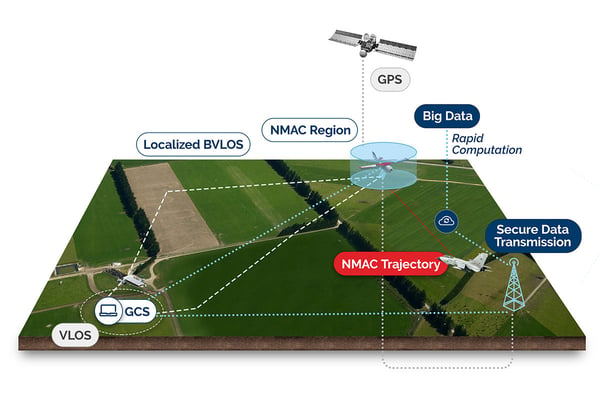 Localized BVLOS operations
Localized BVLOS operations
As opposed to Visual Line of Sight, or VLOS flights, which are performed with the drones within the pilot’s line of sight, BVLOS flights are performed out of visual range. BVLOS capabilities enable a drone to cover far greater distancessignificantly improving the economics and feasibility of many commercial operations.
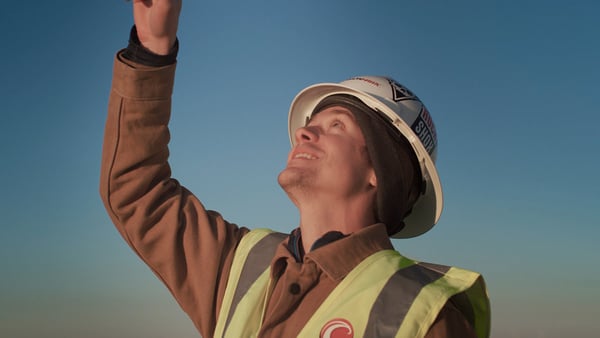 Director of Flight Operations, Matt Tompkins in the field
Director of Flight Operations, Matt Tompkins in the field
Industries Making the Most of BVLOS Drone Flight
Agriculture
Energy
Businesses that Fly BVLOS Benefit in Several Ways
Efficiency
Better Results
Safety
In many cases, drones prevent humans from being placed in a dangerous situation, either removing them from an aircraft or a hazardous area. These areas can be inaccessible for a ground crew, and are often outside VLOS range.
While BVLOS flight is already legal in other countries with certain restrictions, it is not yet allowed in the United States without a hard-to-get waiver from the Federal Aviation Administration (FAA). To date, more than twelve hundred BVLOS waiver applications have been submitted by commercial drone operators. Of these, 99% have failed to earn a permit.
"BVLOS flight unlocks the next generation of surveying applications (and not just for drones). By enabling workers to operate drone-based sensors remotely, businesses can collect data from places they never could before. And everyone—workers, businesses, and the customers they serve—benefit from an overall improvement in safety."
THOMAS HAUN, SVP OF ENTERPRISE SOLUTIONS, PRECISIONHAWK
Reducing Costs with BVLOS Flight — A Case Study
How much money can be saved using BVLOS operations?
Let’s take the electric utilities industry as an example. In their field, high tension power lines must be inspected on a regular basis. Until now, this has typically been done using manned helicopters. Requirements and methodologies vary, but the cost range to do so is roughly $40-$700 per mile.
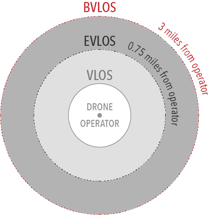
In most cases, utilities operating drones BVLOS would spend roughly $10-$25 per mile of inspection.
So, a company that must inspect 10,000 miles of power lines a year would save $1.7 million in the first year of operation — a savings of nearly $9 million dollars over the course of 5 years.
KEEPING SKIES SAFE
The most pressing challenge facing the drone industry is regulation. As with many industries, drone technology is developing much faster than the regulatory bodies can keep up.
Here, the cautious, risk-averse nature of the aviation industry is in sharp contrast to the speed of innovation. Yet it is precisely the FAA’s conservative nature and careful regulations that have made the airspace above the United States one of the safest places in the world.
The FAA’s main concern is uncontrolled flying that puts lives and vital infrastructure in danger. The agency must be assured that drones sharing the sky with airplanes will not result in midair collisions, and that the risk of damage to people and property on the ground is mitigated.
The FAA’s challenge (and mandate) is to integrate drone technology without introducing an unacceptable level of safety risk into the National Airspace System (NAS)—a task that poses a variety of technical, operational, and regulatory challenges.
We look forward to sharing our experience with businesses and operators in a range of industries. In doing so, our aim is to build on the safety practices we’ve developed—fostering the adoption of drone technology at large.
MICHAEL CHASEN, PRECISIONHAWK CEO
GETTING CLEARED FOR BVLOS FLIGHT
To conduct commercial BVLOS operations, businesses must be granted a BVLOS Part 107 Waiver from the FAA, or work with a provider who has one. To obtain the waiver, operators must prove to the FAA that their drone operations can be conducted safely without endangering other aircraft or people and property on the ground or in the air.
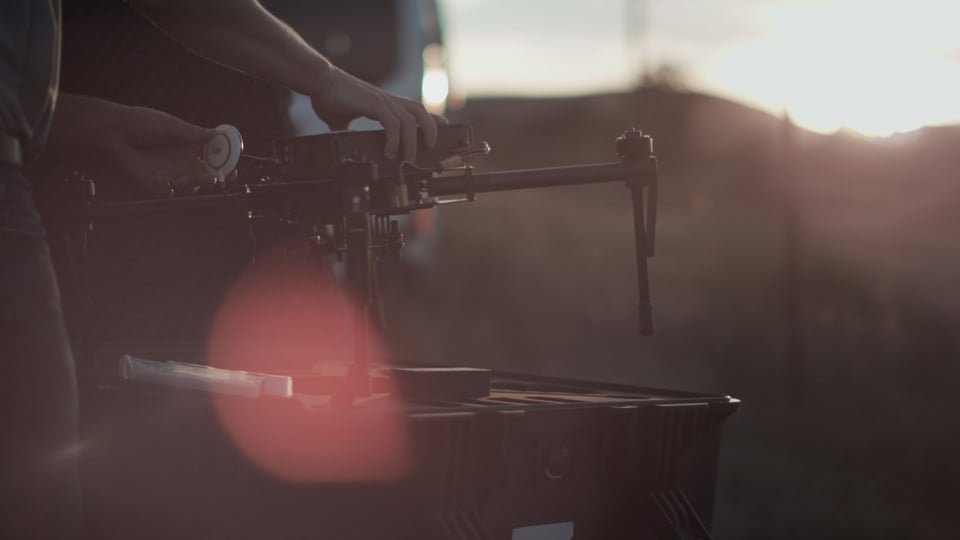
DJI Matrice 100 being prepared for flight
The request seems straightforward enough. But how do you demonstrate safety? How can you mitigate the risks? What data points are involved? How can you even conduct safety research if you can’t operate beyond visual range?
The burden of proof is entirely on the operator. Safety is a complex issue with many moving parts—the FAA evaluates waiver applications based on the totality of operational risk and mitigating efforts.
In a very real sense commercial operators currently seeking a waiver are “flying blind.” Unsurprisingly, the failure rate for obtaining a waiver is staggeringly high and the lucky few who do pass are given a waiver with only the narrowest of flight plans.
The process to obtain a BVLOS waiver is complex, ambiguous and onerous. PrecisionHawk has developed expertise in navigating this process and can share what we know with others. I look forward to working directly with organizations to unlock new possibilities for executing inspections, surveys, precision agriculture, emergency response, and more.
DIANA COOPER, SENIOR VICE PRESIDENT OF POLICY & STRATEGY AT PRECISIONHAWK
Sharing our Pathfinder Initiative Research

On February 26th, 2018, we delivered the final Pathfinder report to the FAA at an event held at the Newseum in Washington, DC.
Michael Chasen, Dr. Allison Ferguson and Diana Cooper, our SVP Policy and Strategy, were joined by key stakeholders engaged in UAS integration including Rob Pappas, FAA UAS Integration Office, Gemechu Gelgelu, FAA Airspace Policy, Matt DeGarmo of MITRE, and Ethan Klein, Emerging Technologies at the White House Office of Science and Technology Policy to discuss how the final results of our Pathfinder research will help shape the requirements for advanced drone operations.
Developing Safety Practices for BVLOS Operations
In 2015, in an effort to to accelerate discovery and inform regulation on drones, the FAA chartered a new initiative. It partnered with three private U.S. companies to gather actionable data on real drone applications and safety scenarios. The project was named The Pathfinder Initiative.
PrecisionHawk was one of the three companies selected to collaborate with the FAA. In 2016, PrecisionHawk was granted the very first BVLOS Part 107 Waiver to conduct commercial operations using unmanned aircraft flying outside of the pilot’s direct vision.
We conducted fieldwork over the course of three years. Our extensive research focused on developing operational and safety practices, as well as recommendations for technologies that enable BVLOS flight.
Our field testing was completed in March 2017. In February 2018, we combined all the real-world data we’d collected, including MITRE simulation data and submitted our report. Then, to help others benefit from our research, we submitted our work to the American Society for Testing and Materials (ASTM).
Now, we are making our research public and available to any company seeking to obtain their own BVLOS waiver.
OUR BVLOS RESEARCH
For three years, we collected data on drone operators in real-world situations. Here’s how it worked:
- We deployed drones in the same environments where commercial operations would likely occur.
- Then, we’d introduce “intruders”—manned aircraft flown by FAA-certified pilots—that would approach the drone’s area of operations from headings unknown to our drone pilots.
- The drone pilots would have to detect this intruder and then decide what to do, while continuing to operate the drone and deal with distractions in the field.
Using this methodology, we conducted more than 600 approaches in the field and combined our observations with those made during in-lab simulations conducted by MITRE. The effort included 75 drone operators in the field and 70 in the simulated environment.
Our concept of operations (ConOps) was based in part on the following constraints:
- In the rural and remote areas in which we were operating, we didn’t use ground infrastructure.
- Also, the equipment we used on the drone needed to be minimal.
These constraints posed a unique challenge for detecting manned aircraft in BVLOS.
We equipped the drone operators on the ground with two screens, one screen showed the Operational View on the Ground Control Station (GCS). The other screen displayed LATAS—our proprietary Low Altitude Tracking and Airspace Safety software—which showed the position and altitude of cooperating aircraft. This setup allowed us to collect a substantial set of both quantitative and qualitative data about the information pilots require in order to avoid a midair collision.
In all, we looked at more than 20 data factors in the drone operator’s decision making. For example. when a manned aircraft is intruding into your airspace, do you move or not? If you move, where do you go? When did the operator detect an issue? How often did they choose to act? If they chose to act, what action did they take? Were they able to prevent midair collisions? Were they able to maintain a well-clear zone? How does the environment and pilot interaction with the assisting technology affect the decision making process? Full details and conditions are available in our technical whitepaper.
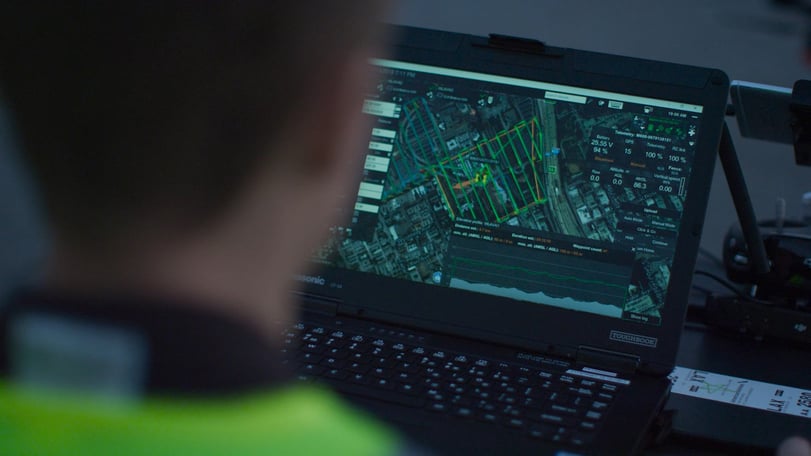
Tracking drone flight with PrecisionFlight Pro
OPERATIONAL RISK ASSESSMENT
We concluded that the key questions that must be asked and quantitatively assessed to generate a thorough BVLOS operational risk assessment (ORA) are:
- What functionality must the assistive technology be capable of to enable safe BVLOS operations in the NAS?
- How do we expect operators to engage with the assistive technology?
- In what ways can this human-machine system fail?
- How do we mitigate the risk of failure?
We did find an anecdotal but nonetheless interesting conclusion. It turns out to be much harder than expected to create well-clear violations with sUAS in realistic scenarios, even when you aim your aircraft right at them.
DR. ALLY FERGUSON DISCUSSING BVLOS OPERATIONS
WHAT IS REQUIRED FOR BVLOS FLIGHT
What we learned is that the flying is the easy part. The more challenging aspects involved ensuring the underlying support systems and infrastructure such as control systems, sensors and data analytics were in place—in other words the safety ecosystem around BVLOS drone flight.
We have found that the three necessary components for BVLOS flight operations are:
Detection
Technology must be able to identify cooperative and non-cooperative aircraft that intrude the drone operator’s airspace (well-clear violations from aircraft) and take evasive action. Also, technology should provide status alerts during operation to indicate reduced functionality, such as lag, latency, and failure.
Safety
Ensure the pilot is aware of existing airspace classes, temporary flight restrictions, and no-fly zones. Also, conduct pre-flight checks of hardware and execute the appropriate flight operations in the event of an in-flight failure.
Drone Operator Training
Pilots must have sufficient experience in VLOS and receive BVLOS-specific training. A practical performance evaluation (in-field test) is necessary to make sure the training is complete.
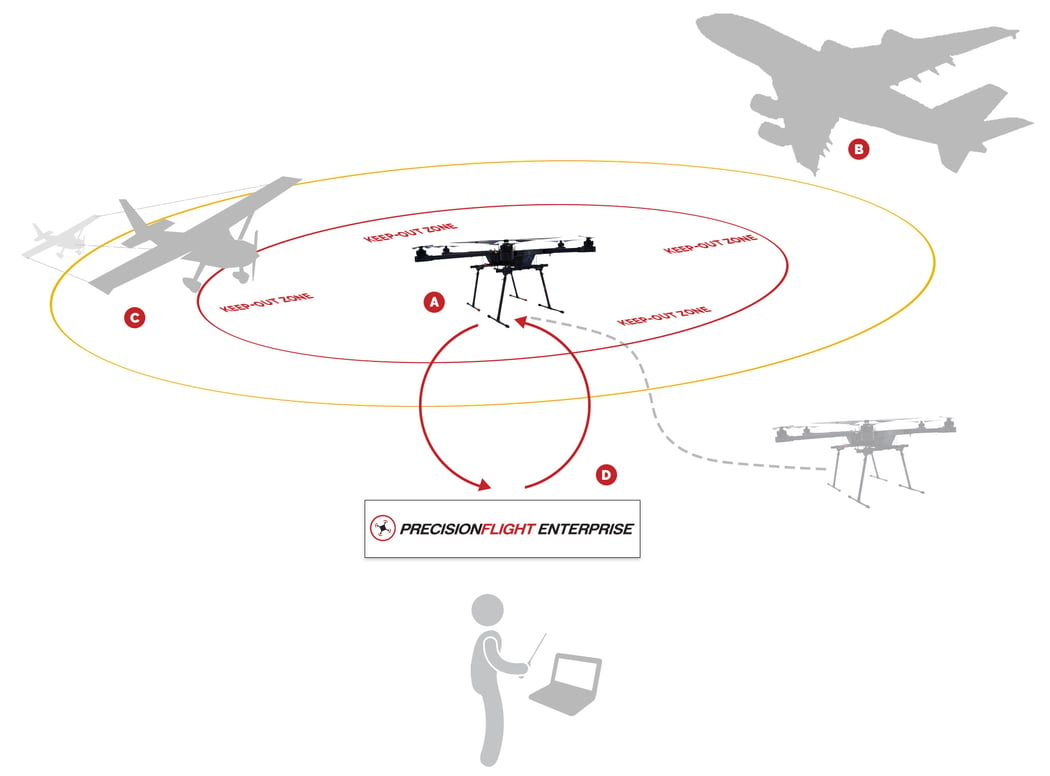
BVLOS Flight Requirements
A
sUAS Tracking - A BVLOS solution must include hardware- and/or software-based systems that transmit the live trajectory information of the sUAS.
B
Real-time Manned Aircraft Data Feed - Cooperative aircraft, and their location and trajectory, must be displayed at one second latency or better.
C
Detect and Avoid System - To detect non-cooperative aircraft, a BVLOS system is required to have an aircraft detect and avoid system with a minimum range of three nautical miles in a 360° field of regard.
D
Display - The assistive technology portfolio must present alerts, visual and audible, to the pilot.
Precision Hawk BVLOS Drone Solution
A
B
C
D
Our final report creates a safety case for non-urban BVLOS operation with the following mitigation:
- Training, with at least 15-20 hours of VLOS flight before BVLOS is attempted and a practical performance evaluation
- A BVLOS flight operations manual with clear directions to minimize risk
- Assistive technology in the form of:
- Real-time tracking of your drone
- A solution for tracking cooperative manned aircraft
- A solution for detecting and avoiding non-cooperative manned aircraft (without a transponder)
TRAINING
We spent a great deal of time with pilots in the field looking at how they reacted in emergency situations. In order to avoid midair collisions, drone operators must respond in a certain way. That’s where training and experience comes in.
Until now, any experience in drone flight involved learning to maintain eye contact with your drone. In VLOS flight you must remain focused on the drone itself. However, when you fly a BVLOS mission a very different, more technical skill set is required.
An operator must be able to respond to the warnings provided and effectively assess airpace through the alerts and data they receive. In order to properly focus on these alerts and data, the pilot must already be very comfortable flying the drone model. It must be second nature. To this end, we recommend BVLOS pilots have 15-20 hours of VLOS flight logged with the same model of drone before BVLOS flight is attempted.
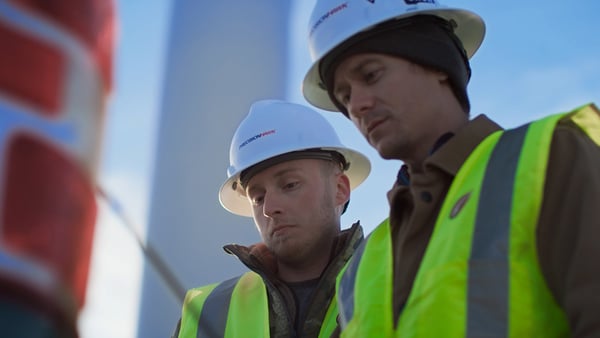
Drone pilots reviewing flight details
BVLOS Drone Technology
Under the regulatory framework for conducting drone operations, drone pilots are required to “see and avoid” other aircraft. On an aircraft with humans in the cockpit, this is easily done. The pilot can simply look out the window to see if another vehicle is too close. But a drone pilot’s eyes are back on the ground, so how can they see and avoid?
This is where assistive technology is key. Luckily, the necessary technology already exists. For Pathfinder, we used LATAS: a combined set of geospatial, software, and hardware tools to facilitate safe drone operation. The platform features specialized display elements, including telemetry and an air traffic map.
Using these elements, the pilot could easily observe their ownship “bubble.” In other words, the relative altitude and horizontal separation of intruding aircraft and other mission-critical measures.
In partnership with leading manufacturers, PrecisionHawk has developed the industry’s first BVLOS-enabled drone platform for commercial users, which incorporates the required assistive technology.
About Dr. Allison Ferguson

Lead Author: Dr. Allison Ferguson, Director of Airspace Safety and Research at PrecisionHawk
Dr. Ferguson is a statistical physicist with more than 15 years experience in using multivariate statistics to develop predictive models. As the lead researcher in PrecisionHawk’s FAA Pathfinder Focus Area Two Initiative, she helped develop data-driven risk assessment of drone operations in the national airspace.
PrecisionHawk BVLOS Consulting Services
So, is it possible to safely conduct BVLOS operations in the national air space? The answer is yes. We’ve done the initial discovery work, so you don’t have to.
We’ve learned the kinds of systems that must be in place, and the kind of training essential for the drone pilot. Our fieldwork has provided critical information to the FAA regarding drone operations. We were asked to encapsulate what we’ve learned into ASTM standards which will be available soon for industry reference.
Industry analysts forecast that commercial drone operations are poised to be a multi-billion market in the next few years. But for us to truly get there we need to fly BVLOS. That’s why we’ve committed the resources to do this important research. We want to help the industry move forward.
MICHAEL CHASEN, PRECISIONHAWK CEO
BVLOS flight is clearly the linchpin for future commercial applications. Now that we’ve developed a framework that helps ensure safe and reliable BVLOS flight, the sky is quite literally the limit. The number of successful applications for which BVLOS drones can be used will continue to grow.
Already, the enterprises for whom we’ve flown BVLOS have benefited from the technique’s expanded reach. They’re getting high-resolution outputs of drone-based data collections, faster and at a lower cost than VLOS drone flight and traditional methodologies.
Over the past three years, the Pathfinder Program has yielded data to support the expansion of FAA-approved drone operations. Through our work we’ve learned about flight operations and best practices for BVLOS safety, but we don’t want to be the only ones in the sky. We’re eager to make the capability accessible to the industry at large and help other companies navigate the regulatory waters of BVLOS flight.
Ultimately, our aim is to create more efficient sharing of airspace for manned and unmanned aircraft and help ensure everyone in the sky and on the ground remains safe.
INTERESTED IN DEPLOYING BVLOS?
PrecisionHawk has already begun working with enterprise clients to integrate BVLOS operations. Through our new BVLOS and Expanded Drone Operations Consulting Program, we address applications like pipeline inspection, environmental monitoring and more.
We bring deep, functional expertise in BVLOS operations to your organization and offer flexibility in how we partner with you.
Option 1:
Service Partner Package
WE PROVIDE THE BVLOS FLIGHT CAPABILITY FOR YOU.
Using our waiver, we act as your BVLOS service partner.
Option 2:
Onsite Training Package
WE TRAIN YOUR PEOPLE IN BVLOS FLIGHT.
Not simply pilot training, but helping you develop a full operations playbook specific to your organization.
Option 3:
Turnkey Package
- Onsite customer needs assessment
- Assistance in drone platform selection based on mission and BVLOS enablement technologies
- Pilot training and performance evaluations
- Developing tailored training materials based on specific mission types
- Drafting of waiver application including the Concept of Operations and Operational Risk Assessment
- Supervision of initial BVLOS flights conducted by the customer under an approved waiver
- Ensuring your entire organization is aligned and set up to successfully deliver BVLOS operations consistent with the company’s objectives
PrecisionHawk’s BVLOS and Expanded Drone Operations Consulting is lead by Diana Cooper—Senior Vice President of Policy & Strategy.
Contact PrecisionHawk today to speak with an expert about adding BVLOS to your operations and unlocking the full potential of commercial drone flight.


